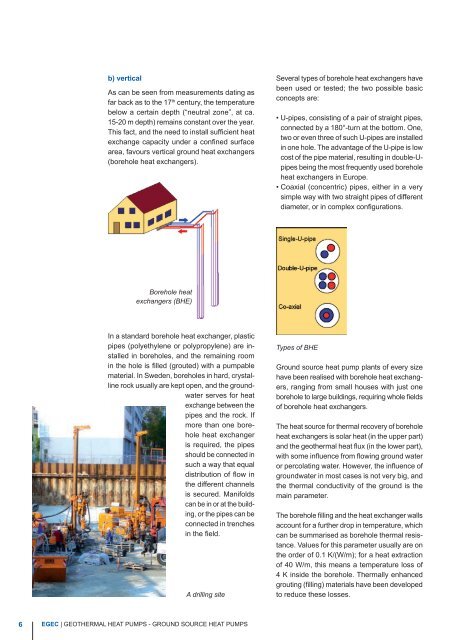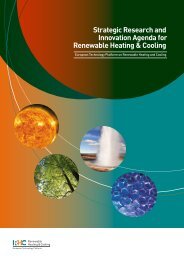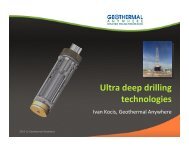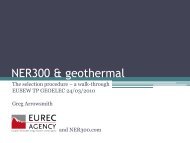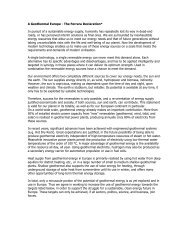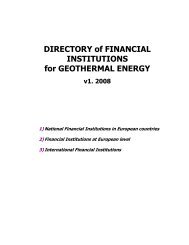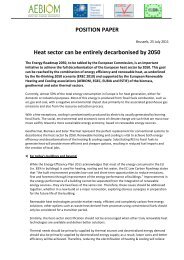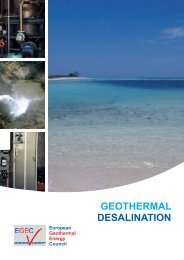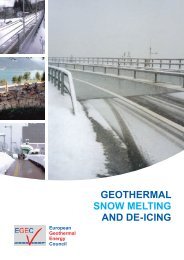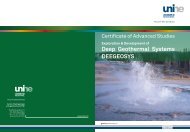GEOTHERMAL HEAT PUMPS - GROUnd SOURCE HEAT ... - EGEC
GEOTHERMAL HEAT PUMPS - GROUnd SOURCE HEAT ... - EGEC
GEOTHERMAL HEAT PUMPS - GROUnd SOURCE HEAT ... - EGEC
You also want an ePaper? Increase the reach of your titles
YUMPU automatically turns print PDFs into web optimized ePapers that Google loves.
) vertical<br />
As can be seen from measurements dating as<br />
far back as to the 17 th century, the temperature<br />
below a certain depth (“neutral zone”, at ca.<br />
15-20 m depth) remains constant over the year.<br />
This fact, and the need to install sufficient heat<br />
exchange capacity under a confined surface<br />
area, favours vertical ground heat exchangers<br />
(borehole heat exchangers).<br />
Several types of borehole heat exchangers have<br />
been used or tested; the two possible basic<br />
concepts are:<br />
• U-pipes, consisting of a pair of straight pipes,<br />
connected by a 180°-turn at the bottom. One,<br />
two or even three of such U-pipes are installed<br />
in one hole. The advantage of the U-pipe is low<br />
cost of the pipe material, resulting in double-Upipes<br />
being the most frequently used borehole<br />
heat exchangers in Europe.<br />
• Coaxial (concentric) pipes, either in a very<br />
simple way with two straight pipes of different<br />
diameter, or in complex configurations.<br />
Borehole heat<br />
exchangers (BHE)<br />
In a standard borehole heat exchanger, plastic<br />
pipes (polyethylene or polypropylene) are installed<br />
in boreholes, and the remaining room<br />
in the hole is filled (grouted) with a pumpable<br />
material. In Sweden, boreholes in hard, crystalline<br />
rock usually are kept open, and the groundwater<br />
serves for heat<br />
exchange between the<br />
pipes and the rock. If<br />
more than one borehole<br />
heat exchanger<br />
is required, the pipes<br />
should be connected in<br />
such a way that equal<br />
distribution of flow in<br />
the different channels<br />
is secured. Manifolds<br />
can be in or at the building,<br />
or the pipes can be<br />
connected in trenches<br />
in the field.<br />
A drilling site<br />
Types of BHE<br />
Ground source heat pump plants of every size<br />
have been realised with borehole heat exchangers,<br />
ranging from small houses with just one<br />
borehole to large buildings, requiring whole fields<br />
of borehole heat exchangers.<br />
The heat source for thermal recovery of borehole<br />
heat exchangers is solar heat (in the upper part)<br />
and the geothermal heat flux (in the lower part),<br />
with some influence from flowing ground water<br />
or percolating water. However, the influence of<br />
groundwater in most cases is not very big, and<br />
the thermal conductivity of the ground is the<br />
main parameter.<br />
The borehole filling and the heat exchanger walls<br />
account for a further drop in temperature, which<br />
can be summarised as borehole thermal resistance.<br />
Values for this parameter usually are on<br />
the order of 0.1 K/(W/m); for a heat extraction<br />
of 40 W/m, this means a temperature loss of<br />
4 K inside the borehole. Thermally enhanced<br />
grouting (filling) materials have been developed<br />
to reduce these losses.<br />
6<br />
<strong>EGEC</strong> | <strong>GEOTHERMAL</strong> <strong>HEAT</strong> <strong>PUMPS</strong> - GROUND <strong>SOURCE</strong> <strong>HEAT</strong> <strong>PUMPS</strong>


